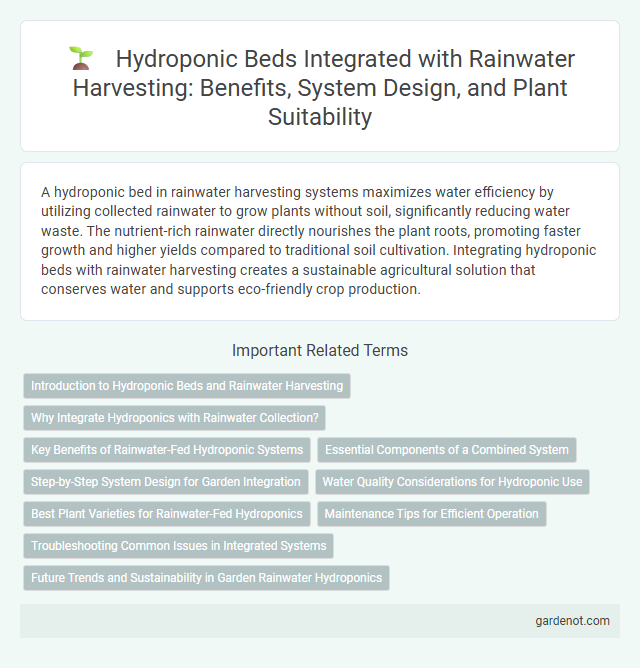A hydroponic bed in rainwater harvesting systems maximizes water efficiency by utilizing collected rainwater to grow plants without soil, significantly reducing water waste. The nutrient-rich rainwater directly nourishes the plant roots, promoting faster growth and higher yields compared to traditional soil cultivation. Integrating hydroponic beds with rainwater harvesting creates a sustainable agricultural solution that conserves water and supports eco-friendly crop production.
Introduction to Hydroponic Beds and Rainwater Harvesting
Hydroponic beds provide a soil-free method for growing plants using nutrient-rich water solutions, making them highly efficient in water use. Integrating rainwater harvesting systems with hydroponic beds captures and stores rainwater, reducing reliance on municipal water supplies and enhancing sustainability. This combination promotes eco-friendly agriculture by recycling natural rainfall and optimizing water resources for plant growth.
Why Integrate Hydroponics with Rainwater Collection?
Integrating hydroponic beds with rainwater collection maximizes resource efficiency by providing a sustainable, nutrient-rich water supply that supports plant growth without relying on traditional irrigation systems. This combination reduces water waste, mitigates dependency on municipal water sources, and enhances crop yield in controlled environments. Utilizing rainwater minimizes the impact of contaminants and chemicals found in tap water, promoting healthier plant development in hydroponic systems.
Key Benefits of Rainwater-Fed Hydroponic Systems
Rainwater-fed hydroponic systems reduce reliance on municipal water, promoting sustainable agriculture by utilizing a renewable resource with minimal chemical content. The natural purity of rainwater enhances plant growth and nutrient absorption, leading to higher crop yields and improved quality. Integrating rainwater harvesting with hydroponics also lowers operational costs and reduces environmental impact by minimizing water wastage and runoff.
Essential Components of a Combined System
A combined hydroponic bed system for rainwater harvesting integrates essential components such as a water storage tank, filtration units, and a nutrient delivery network to ensure clean, nutrient-rich water supply. The system relies on channels and pumps to circulate harvested rainwater through grow beds, optimizing plant hydration and growth. Incorporating sensors for moisture and nutrient levels enhances efficiency by maintaining optimal conditions within the hydroponic environment.
Step-by-Step System Design for Garden Integration
Step-by-step system design for integrating a hydroponic bed with rainwater harvesting begins by selecting a suitable bed location ensuring optimal sunlight exposure and easy access to collected rainwater. Next, install a rainwater catchment system connected to a filtration unit that supplies clean water directly to the hydroponic nutrient reservoir. Finally, configure the pump and irrigation tubing to evenly distribute nutrient-rich water throughout the hydroponic bed, promoting efficient plant growth and water conservation.
Water Quality Considerations for Hydroponic Use
Maintaining optimal water quality is essential for hydroponic beds using rainwater harvesting systems. Parameters such as pH levels, electrical conductivity (EC), and nutrient concentration must be monitored to ensure plant health and maximize nutrient uptake. Filtration and UV treatment are effective methods to remove impurities and pathogens, promoting safe and efficient hydroponic water use.
Best Plant Varieties for Rainwater-Fed Hydroponics
Leafy greens such as lettuce, spinach, and kale thrive in rainwater-fed hydroponic beds due to their fast growth and nutrient absorption. Herbs like basil, mint, and cilantro benefit from the clean, mineral-balanced rainwater, enhancing flavor and yield. Strawberries and cherry tomatoes also perform well, leveraging the consistent moisture and natural nutrient composition of harvested rainwater.
Maintenance Tips for Efficient Operation
Regularly inspect and clean the hydroponic bed to prevent algae and nutrient buildup, ensuring optimal water flow and plant health. Monitor pH and nutrient levels frequently to maintain a balanced solution that supports robust growth. Replace or replenish the nutrient solution every 1-2 weeks to avoid stagnation and nutrient depletion in rainwater-harvested systems.
Troubleshooting Common Issues in Integrated Systems
Hydroponic beds in rainwater harvesting systems often face challenges such as nutrient imbalances, root rot, and inconsistent water flow. Addressing these issues requires regular monitoring of pH levels between 5.5 and 6.5, ensuring proper aeration, and maintaining a steady supply of clean harvested rainwater to prevent clogging and disease. Implementing automated sensors and filtration units enhances system stability and promotes healthy plant growth.
Future Trends and Sustainability in Garden Rainwater Hydroponics
Future trends in garden rainwater hydroponics emphasize the integration of smart sensors and automated systems to optimize water use efficiency and nutrient delivery. Sustainable practices include closed-loop water recycling and the use of biodegradable growth media to reduce environmental impact. Advances in renewable energy-powered pumps and AI-driven monitoring systems enhance the scalability and eco-friendliness of hydroponic beds.
Hydroponic bed Infographic

 gardenot.com
gardenot.com